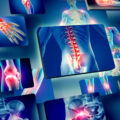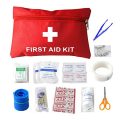Accidents can cause a wide variety of injuries because no part of your body is immune to acute injury. You could roll your ankle playing in the backyard with friends and family, throw out your back lifting something heavy around the house, or hurt your back in a car accident. Some of the most common injuries to result from accidents are fractures; dislocations; concussions; soft-tissue injuries like muscle, ligament or tendon strains and sprains; nerve damage or impingement; and whiplash.
Regardless of how safe or careful you are, accidents happen. Whether something goes wrong at work, at play, or in the car, chances are you will be injured in an accident at one point or another in your life.
Types of Pain
You know your pain better than anyone. And as hard as it’s been to handle it, your experience holds the key to making a plan to treat it. Each person and their pain are unique. The best way to manage your case could be very different from what works for someone else.
Acute pain starts suddenly and usually feels sharp. Broken bones, burns, or cuts are classic examples..Acute pain may be mild and last just a moment. Or it may be severe and last for weeks or months. In most cases, acute pain does not last longer than 6 months, and it stops when its underlying cause has been treated or has healed.
Chronic pain on the other hand lasts longer than 6 months, often despite the fact that an injury has healed. It could even last for years.
Accident and Injury Causes
Injuries resulting from accidents are generally caused by violent gravitational forces, blunt force trauma or falls. The nature of your accident will largely determine the type and extent of your injuries because things like automobile accidents and falls will lead to more traumatic injuries than general wear-and-tear caused by repetitive use injuries, as is common with office workers (carpal tunnel syndrome) and manual laborers (joint pain and arthritis). Pain that is caused by damage to muscles, bones or organs, as is the case with pain caused by acute injury, is known as nociceptive pain; it can go away on its own as the tissues heal, but medical intervention is often required to achieve full resolution of painful symptoms. If you do not treat nociceptive pain, there is a chance it can turn into chronic pain, as the underlying cause goes untreated and the pain therefore never goes away.
Symptoms of Accidents and Injuries
The symptoms of an acute injury can range in severity from mild to severe and have an immediate onset or come on gradually over time. The most common symptoms of an injury are pain, swelling, loss of mobility and redness. In severe cases, there could even be visual changes at the site of injury, as is the case with broken or dislocated bones. Pain, whether it is acute or chronic, is your body’s way of telling you that something is wrong, so you should never ignore chronic pain. Doing so is essentially ignoring your body’s messages that something is wrong. Furthermore, waiting too long to seek medical treatment after an injury will not only prolong your suffering, it could actually make an injury worse as some conditions have windows in which they need to be treated to ensure optimal outcomes.
Accidents and Injuries Diagnosis
If you have been involved in an accident or have been injured at work, the first step towards a diagnosis is scheduling an appointment with a physician whose practice is focused on treating injuries arising from an accident. At the time of your appointment, they will complete a full review of your individual and family medical history; conduct a thorough physical examination and order and review any necessary diagnostic tests, such as X-Ray, MRI or CT scans. The results of these examinations and diagnostic tests will help your physician pinpoint the cause of your pain and develop a treatment plan aimed at eliminating it.
How To Reduce Pain After Accident
If you are experiencing the signs and symptoms of pain, there are several options that can help alleviate your pain and get your life back on track. This includes;
Oral pain relievers
That bottle of pain-relieving pills in your medicine cabinet likely contains aspirin, ibuprofen (e.g., Advil and Motrin IB) or naproxen sodium (e.g., Aleve). These medications are most effective for mild to moderate pain that’s accompanied by swelling and inflammation, such as sprains and strains.
Massage therapy – a very popular complementary therapy that aims to use soft tissue manipulation to reduce pain and inflammation in the muscles that support the spine.
Physical Therapy – a combination of stretching, strengthening and cardiovascular exercises aimed at strengthening the muscles around the site of injury, which can help relieve pain and allow the injury to heal.
Bracing – certain braces can help relieve pain in injured joints by removing some of the pressure on the site of injury.
Topical creams – Certain topical creams, particularly those that contain capsaicin, menthol or salicylates, can help provide short-term but immediate relief for acute pain.
Manage or reduce stress
Stress can trigger muscle tension and painful spasms, including in the back. If long-term stress or a traumatic event seems to have caused back pain, a person can try stress-relief techniques, such as:
- Mindfulness meditation. One study showed that mindfulness-based stress reduction improved back pain. Mindfulness involves being aware of what the body is doing and using meditation techniques to assist with the pain.
- Deep breathing. Taking deep breaths in and out for several minutes can calm the body’s stress response.
- Progressive muscle relaxation. This involves tensing and relaxing muscles in the body, focusing on one muscle group at a time. Lying on their back, a person can start with their feet and gradually move up to the shoulders.
- Guided imagery. This involves focusing on specific mental images to bring about a feeling of relaxation. One study found guided imagery and music helps with work-related chronic stress.
- Yoga. Yoga focuses on particular poses and breathing and can help with relaxation, especially when practiced regularly. One review found yoga to be an effective stress management tool.
Many smartphone apps are available to guide a person through relaxation techniques and meditation.
When to See a doctor
People can often treat minor pain with home remedies and some patience. However, a person should speak to a doctor about chronic or acute pain. A doctor may recommend physical therapy, medication, or other treatments. People who have existing health conditions or who take regular medications should speak to a doctor before trying any herbs or supplements. READ:How Effective is Neurovit Forte For Nerve Pain?






